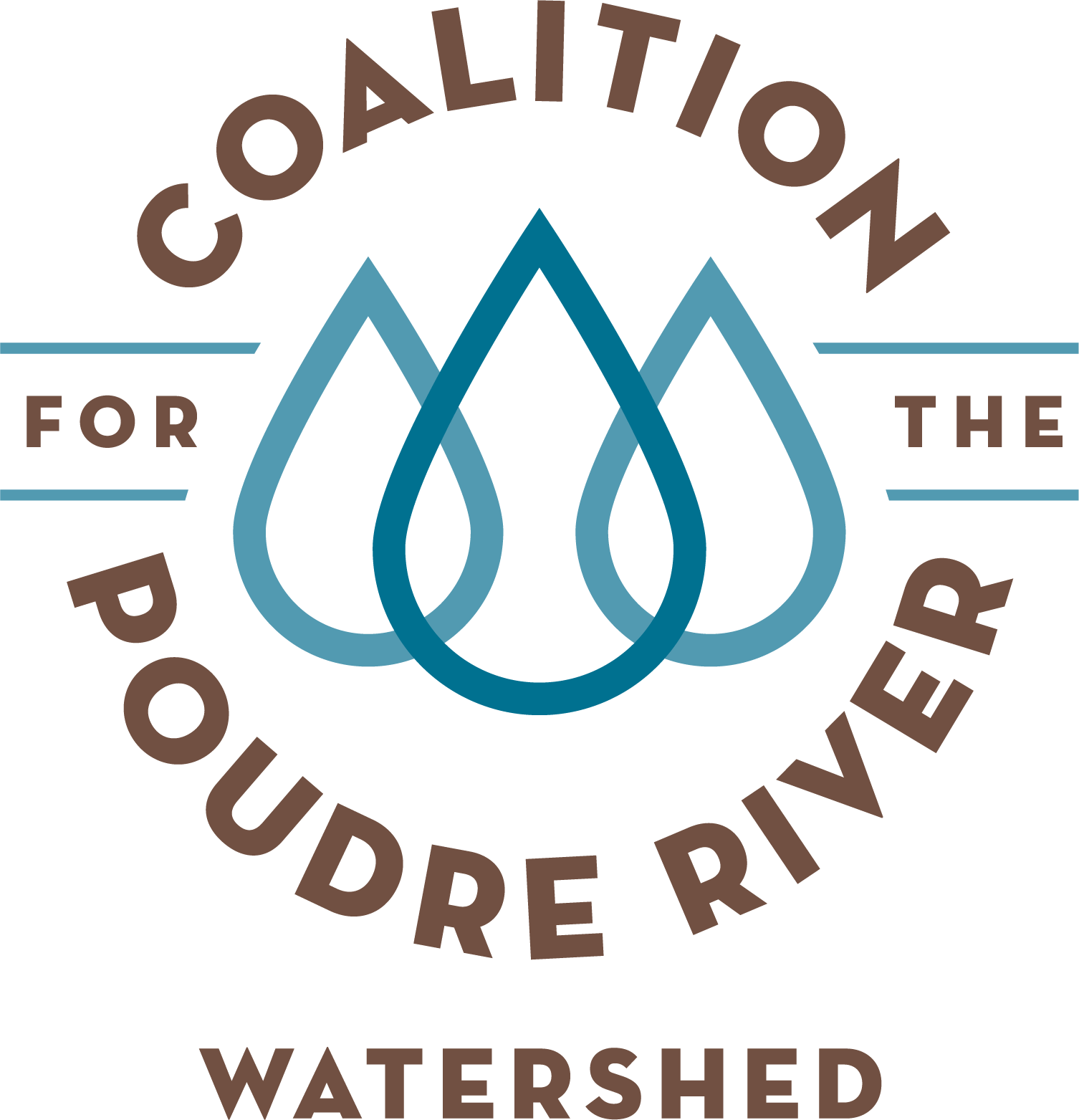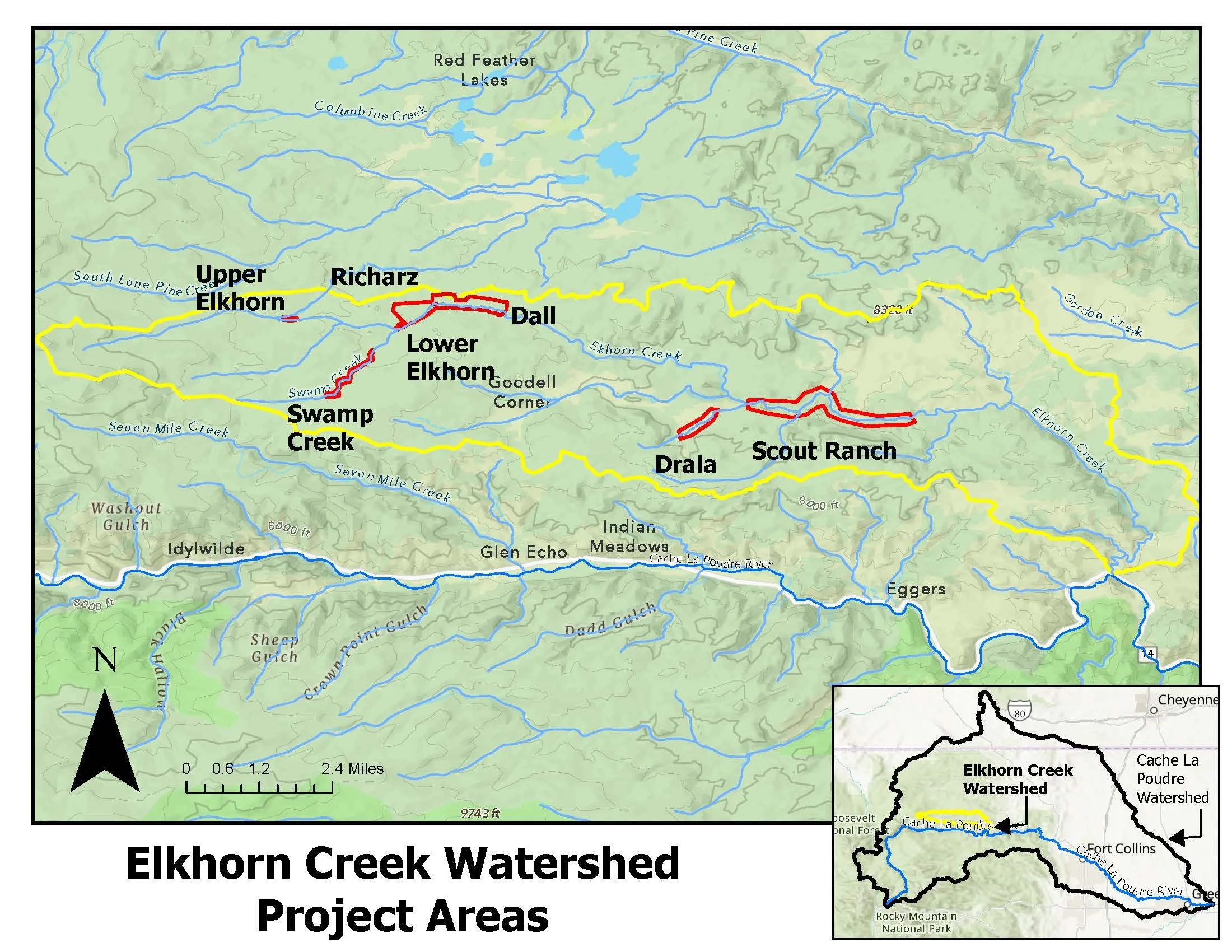Lower Elkhorn Creek
Cameron Peak Post-Fire Restoration
Lower Elkhorn Creek is located in the Cameron Peak burn area - pre-construction - June 2025 (Ben Sellers/Covering Ground Mapping)
Project Overview
Elkhorn Creek plan. Click map to enlarge.
Elkhorn Creek was determined to be a high priority site to meet CPRW water quality objectives and US Forest Service values, and this site ranked in the top five of over two dozen sites in CPRW’s prioritization. It is located within a moderate-severity burn area outside of Wilderness designation areas. Approximately 4% of the watershed was mulched in 2022. The site has been heavily influenced by not only the Cameron Peak Fire, but also current and past land uses.
The Elkhorn Creek Watershed was significantly burned during the Cameron Peak Fire, leading to channel degradation and water quality impairments. Approximately 91% of the watershed contributing to this site was burned. The JW Hazard Assessment classified the upper portions of Elkhorn Creek watershed as a “high” hazard system and the Swamp Creek tributary watershed as “moderate” hazard. A hydrologic analysis performed by Enginuity Engineering Solutions indicated that post-fire flows would increase by nearly 400% compared to pre-fire flows for events with a 10-year recurrence interval or less. Increases in runoff have and will continue to increase sediment and nutrient inputs from adjacent burnt hillslopes to the stream, thereby degrading water quality and aquatic habitat. Impact from post-fire hydrology changes will also likely result in increased downcutting, reduced floodplain connectivity, and impairment of ecological processes.
Low-tech process-based restoration techniques are being used at this site. Structures were strategically placed at locations with significant incision, relic beaver dams, or riparian degradation to increase roughness, reduce flow velocities, and promote sediment deposition both behind features and on the overbank. These features will enhance nutrient uptake while increasing wetland and aquatic habitat value.
In 2022, CPRW and partners completed the Upper Elkhorn Creek project, just upstream of this project area. In 2025, we will be completing work on a complimentary project also upstream of this project on the Richarz property. In 2026, two more projects are planned as well. Connecting these projects creates redundancy in our treatments, increases habitat connectivity, and creates resiliency on a watershed scale.
Post-Fire Treatments
Log Structures – Large, woody material, harvested on-site, will be placed and interlocked in the channel to increase hydraulic roughness, reduce flow velocities, and enhance sediment deposition. Log Structures provide opportunity for sediment storage behind the structures while promoting aquatic habitat complexity and additional wood recruitment to the river system. They can also enhance nutrient uptake and riparian health by increasing groundwater exchange between the channel and floodplain sediments.
Post-Assisted Log Structure (PALS) – On-site woody material of various sizes will be pinned together with untreated posts driven into the streambed to initiate and simulate natural wood accumulation. PALS provide opportunities for sediment storage behind the structures while promoting floodplain connectivity, additional wood recruitment, and riparian health. These features were field fit by the design team and placed to encourage sediment deposition. Placement utilized the relic beaver dams, where feasible, to reintroduce water areas behind the dams and promote riparian vegetation growth.
Willow Wattles – Willow stakes are harvested off-site and bundled using biodegradable twine. These bundles are then partially buried and staked into areas with regular baseflow where willows would naturally grow. Willow wattles provide water quality improvements through rapidly establishing woody riparian vegetation to increase sediment storage and nutrient uptake.
Riparian Revegetation - Recovery of riparian ecosystems is vital to improving water quality. Establishing woody riparian vegetation, primarily willows, increases the capacity for sediment storage, nutrient uptake, and habitat complexity in riparian and aquatic ecosystems. These willows will be incorporated into the log structures and PALS to provide additional support.
Proposed features were strategically placed to encourage surface and groundwater flow into historic alluvial flow paths whenever possible. In channel features will contribute to sediment deposition, nutrient uptake, and channel complexity while increasing wetland and aquatic habitat value.
Photography by Evan Barrientos
Paring forestry and stream restoration work
CPRW and Larimer County Conservation Corps (LCCC) are using woody biomass from a wildfire mitigation project just upstream of this site to construct some of the instream structures.
Demonstrating paired forestry and stream restoration treatments in both burned and unburned areas helps build resilience across the greater Poudre River watershed. It also highlights the value of integrating these approaches to maximize the benefits of forest management, stream restoration, and local wood product utilization.
Project Goals
Improve water quality and ecological functioning by providing opportunities for sediment storage, nutrient uptake, and enhanced aquatic and riparian habitats.
Improve stream processes in Elkhorn Creek that align with downstream Wild and Scenic recreation, aesthetic, fisheries, and aquatic habitat values in the Cache la Poudre River.
Use process-based restoration techniques to meet the project objectives.
Connect upstream project on Elkhorn Creek to improve landscape-level riparian conditions (see map below)
Demonstrate paired forestry and stream restoration treatments.
Project Collaborators
United States Forest Service (USFS)
Ayres Associates (Design & Engineering)
AloTerra Restoration Services (Construction)
Colorado State University (Research & Monitoring)
Funders
Colorado Department of Public Health and Environment (CDPHE)
Colorado Water Conservation Board (CWCB)
Project Timeline
Completed - Summer/Fall 2025









